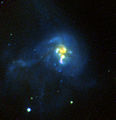Luminous infrared galaxy
A luminous infrared galaxy (LIRG), is a galactic body whose defining characteristic is in emitting more than 1011 solar luminosities in the far-infrared part of the electromagnetic spectrum. A more luminous system, emitting more than 1012 solar luminosities in the far-infrared, is called ultraluminous infrared galaxy (ULIRG). An even more luminous system, emitting more than 1013 solar luminosities in the far-infrared, is called hyperluminous infrared galaxy (HLIRG). Most LIRGs and ULIRGs emit at least 90% of their light in the infrared.
Most LIRGs and all ULIRGs show signs of recent or continuing interactions and disruptions. Many are starburst galaxies, and some also contain an active galactic nucleus. On average, ULIRGs spawn about 100 new stars yearly, as compared to our own galaxy which spawns one new star a year. ULIRGs are implicated in a variety of interesting astrophysical phenomena including the formation of quasars and elliptical galaxies. Local examples of ULIRGs are often used as analogs of galaxy formation at high redshift. ULIRGs seem to be embedded in dark matter halo with masses of around 10 trillion solar masses.
Gallery
-
Ultraluminous Infrared Galaxy IRAS 19297-0406
See also
- II Zw 96 - a luminous infrared galaxy containing young powerful starburst regions.
- NGC 6240 - a luminous infrared galaxy with two nuclei.
- Arp 220 - the closest known ultraluminous infrared galaxy.
References
- ^ "A very bright contortionist". ESA/Hubble Picture of the Week. Retrieved 14 June 2013.
- ^ "A tale of galactic collisions". ESA/Hubble Picture of the Week. Retrieved 6 May 2013.
- ^ "A galaxy colourfully on the wane ain't dead yet". ESA/Hubble Picture of the Week. Retrieved 12 November 2012.
External links
- Nearby Extreme Galaxies Linked To Humble Roots (SkyNightly) Jun 07, 2006
- How To Bake A Galaxy (SpaceDaily) Jun 19, 2006
- The Great Observatory All-sky LIRG Survey

![South America Galaxy taken by the Hubble Space Telescope[1]](http://upload.wikimedia.org/wikipedia/commons/thumb/9/9c/A_very_bright_contortionist.jpg/120px-A_very_bright_contortionist.jpg)
![2MASX J05210136-2521450.[2]](http://upload.wikimedia.org/wikipedia/commons/thumb/3/3f/A_tale_of_galactic_collisions.jpg/120px-A_tale_of_galactic_collisions.jpg)
![Luminous infrared galaxy NGC 5010.[3]](http://upload.wikimedia.org/wikipedia/commons/thumb/0/0c/Potw1245a.tif/lossy-page1-120px-Potw1245a.tif.jpg)
